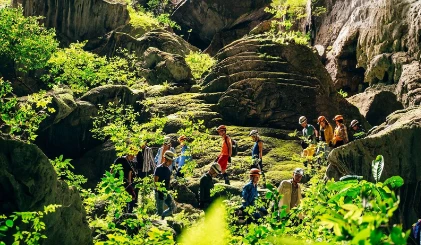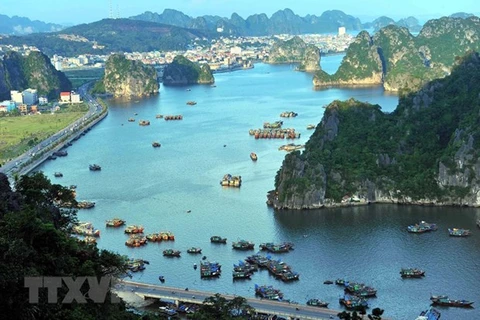Quang Ninh (VNA) – Authorities are quickly taking measures to minimise direct impacts on and maintain the stability of Hon Trong Mai (Kissing Rocks) in line with Vietnam’s regulations and the Convention Concerning the Protection of the World Cultural and Natural Heritage, said the Ha Long Bay Management Board.
Hon Trong Mai, emblematic of word natural heritage site Ha Long Bay in northern Quang Ninh province, are among the many limestone formations in the bay. In the shape of a pair of cock and hen facing each other, they comprise 40 stone blocks, including 11 on the rock of Trong (Cock) and 29 on the Mai (Hen), and now are at high risk of collapse.
The system of faults in the area is the objective cause of rock collapses in Ha Long Bay. The phenomenon has occurred frequently over the last millions of years and will continue in the future. Some formations with special shapes like Hon Trong Mai, Con Coc (Toad), Cho Da (Stone Dog), and Dau Nguoi (Human Head) came into being as results of such rockslides and collapses, head of the board Vu Kien Cuong told a press meeting on August 29.
The board has coordinated with the Quang Ninh provincial Department of Science and Technology and the Vietnam Institute of Geoscience and Mineral Resources to conduct a study on the status of and factors affecting Hon Trong Mai to work out conservation measures.
They have proposed some measures, both social and structural, for minimising direct impacts on and keep the stability of the iconic rocks, Cuong noted.
Ha Long Bay was recognised as a world natural heritage site by UNESCO twice, in 1994 for its globally outstanding aesthetic values and in 2000 for its geological - geomorphological values.
The recognised area covers 434 sq.km and consists of 775 limestone islets of all sizes – one of the core factors of the heritage’s values./.
Hon Trong Mai, emblematic of word natural heritage site Ha Long Bay in northern Quang Ninh province, are among the many limestone formations in the bay. In the shape of a pair of cock and hen facing each other, they comprise 40 stone blocks, including 11 on the rock of Trong (Cock) and 29 on the Mai (Hen), and now are at high risk of collapse.
The system of faults in the area is the objective cause of rock collapses in Ha Long Bay. The phenomenon has occurred frequently over the last millions of years and will continue in the future. Some formations with special shapes like Hon Trong Mai, Con Coc (Toad), Cho Da (Stone Dog), and Dau Nguoi (Human Head) came into being as results of such rockslides and collapses, head of the board Vu Kien Cuong told a press meeting on August 29.
The board has coordinated with the Quang Ninh provincial Department of Science and Technology and the Vietnam Institute of Geoscience and Mineral Resources to conduct a study on the status of and factors affecting Hon Trong Mai to work out conservation measures.
They have proposed some measures, both social and structural, for minimising direct impacts on and keep the stability of the iconic rocks, Cuong noted.
Ha Long Bay was recognised as a world natural heritage site by UNESCO twice, in 1994 for its globally outstanding aesthetic values and in 2000 for its geological - geomorphological values.
The recognised area covers 434 sq.km and consists of 775 limestone islets of all sizes – one of the core factors of the heritage’s values./.
VNA

























